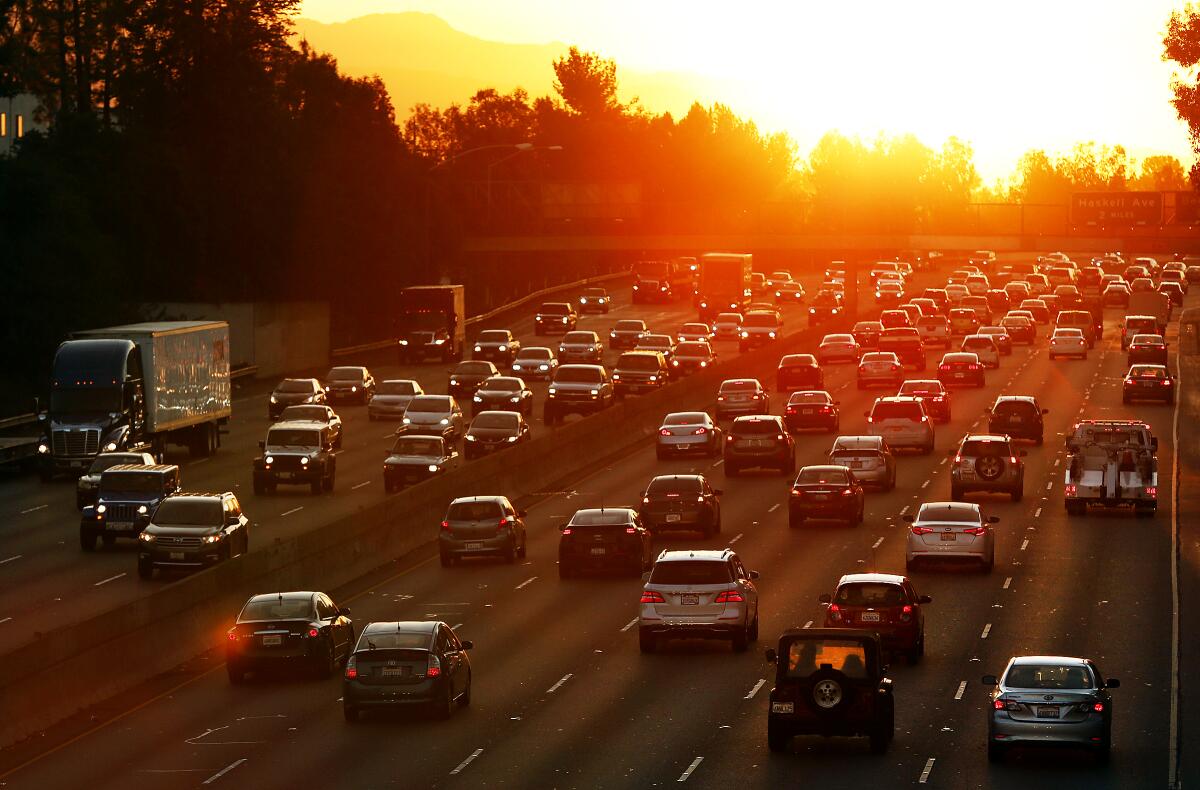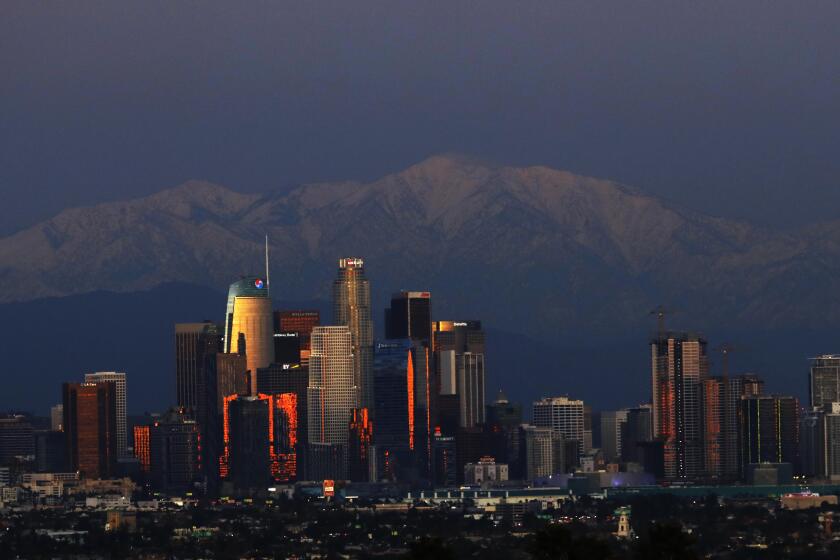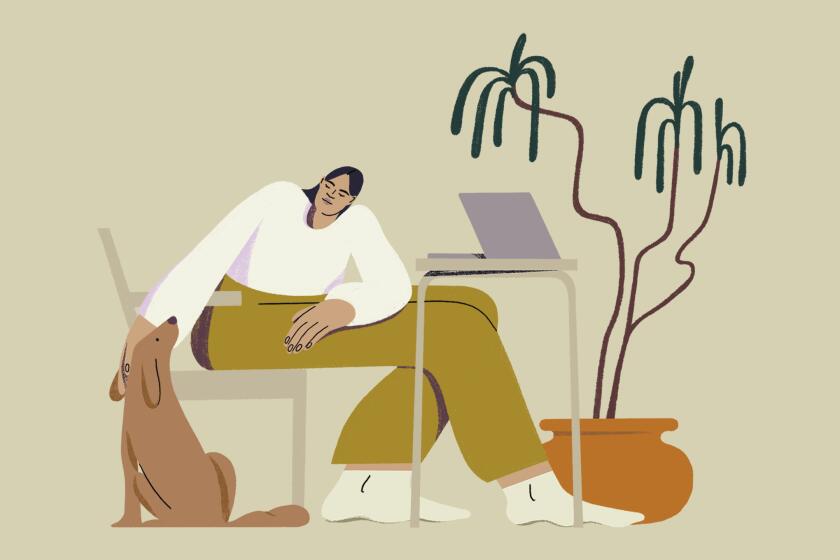Traffic is terrible again. Here’s how to get it closer to spring 2020 levels

We asked readers last month to send in their burning business-related questions about Los Angeles and California.
Readers voted on which question we should answer first. The winner was submitted by Nick Keith, a Santa Ana resident: “What would it take to get our traffic under control like it was back in April 2020?”
Keith, who works in information security, has been frustrated by the return to traffic congestion in Southern California. “It just seems it’s been increasing,” Keith said. “It’s kind of a bummer.”
Commuting is a big part of our lives. Let’s take a quick look at what traffic patterns were before the pandemic, how they changed and where we are now.
Keith’s observation about traffic is correct. As my colleague Andrea Chang reported last month, traffic surged even before California’s official economic reopening on June 15, returning to near-normal levels in Los Angeles and beyond.
Whatever’s puzzling you about life in L.A. and California, we want to hear about it.
On June 30, daily traffic in Los Angeles and Orange counties was above pre-pandemic levels by 4%, according to the traffic data company Inrix. Traffic during peak morning hours was 86% of pre-pandemic levels for Wednesdays, while traffic during peak afternoon hours was the same as pre-pandemic levels.
The most extreme increase in traffic based on June 30’s data was observed during off-peak hours, during which Inrix found traffic to be 14% higher than pre-pandemic levels. This may point to the flexibility of people who are still working remotely.
Leisure travel has also largely boomeranged back to pre-pandemic levels. “We had more people [taking road trips] for the Fourth of July [this year] than we did for the Fourth of July pre-pandemic,” said Doug Shupe, corporate communications and programs manager at AAA, based on numbers from July 1 to July 6.
Keith’s hunch as to how traffic congestion could be curbed? “Working from home really should be more available to people,” he said.
More robust public transportation would also help, he said: “If I were to take a bus from my house in Santa Ana up to L.A., you’re looking at almost three hours.... The infrastructure is not there.”
Digging into Keith’s question brought to light another issue: Do we even want to return to April 2020 traffic levels?
Traffic levels tanked in the early months of the pandemic, said Bob Pishue, an analyst at Inrix, cut roughly in half by the beginning of April 2020. “We haven’t seen a drop in traffic like this since traffic data has been collected on how people drive, which is 50 years, 60 years,” Pishue said.
The decline was an indication of the pandemic’s devastation on the economy and society as a whole, experts say — and that’s why we might not wish to re-create the situation.
“It might be hard to really get us down to where we were in April of last year,” said Michael Manville, an associate professor of urban planning at the UCLA Luskin School of Public Affairs. “Traffic is a product of people having places to go. And we don’t want to go back to a place where no one has any place to go.”
“I wish [traffic] could get back to the way it was but understand that we cannot live in the past,” Keith said via email.
Luckily, it’s possible to make a big difference in congestion without changing the habits of all that many people. “It’s the last few vehicles on the road that are responsible for most of the delays,” Manville explained.
Here are some ways we could chip away at the region’s headache-inducing traffic congestion.
Work from home is a factor
Employers that allow employees to work remotely several days a week could ease the traffic burden in job centers to some extent, my colleague Hayley Smith reported.
She noted that at least 70% of U.S. workers say they would prefer to switch to a hybrid work-from-home schedule or stay remote full time, according to a recent survey by the Society for Human Resource Management.
“Based on the pandemic experience, it is estimated that 1 in 3 workers could do their jobs entirely from home,” Times editorial writer Kerry Cavanaugh wrote in June. “A larger portion of the workforce could do some of their job remotely if we, the users of services, are willing to incorporate more virtual medicine, education and other activities into our lives.”
Love remote work? Here are expert tips for how to negotiate a permanent work-from-anywhere arrangement with your boss.
But despite the societal and professional benefits of remote and flexible work arrangements, many employers remain resistant to the idea, Cavanaugh notes.
A possible solution? Cavanaugh says companies could be encouraged to embrace remote work with financial incentives, tax breaks and other regulatory perks.
Lawmakers could also push for remote work for some government employees, an arrangement Gov. Gavin Newsom has already endorsed.
If you want, you can contact your elected officials to encourage these initiatives and other traffic reduction strategies. Find out who they are at usa.gov/elected-officials. Los Angeles city residents can get a more detailed breakdown at neighborhoodinfo.lacity.org.
Shifting work hours so that fewer professionals commute during the same hours could also help, Pishue said.
Congestion pricing
Charging drivers to use freeways — also known as congestion pricing — is the key, some experts say.
“If we want to get close to [April 2020 congestion levels], what we have to do is price our freeways,” said Manville. “Traffic congestion arises because there’s excess demand and scarce road space.”
Manville notes that people generally accept being charged for utilities such as water and electricity, and argues that road use could be the same. “Normally, for many other goods, we mediate supply and demand for the price. When we don’t use a price, we end up having a shortage,” Manville said. “That’s all congestion is — it’s just a long, slow moving line of people waiting to get access to the road.”
The concept of paying to use roads is familiar to many Californians. The FasTrak toll system has existed for decades.
Cities such as Singapore and London have implemented congestion pricing. “In places where a price has been used, congestion goes down, even in very dense urban areas. If you use pricing, you can control your traffic. If you don’t, you won’t,” Manville said.
So why is congestion pricing so controversial?
AAA has asked government agencies to explore certain questions about congestion pricing, Shupe said, but notes that it could create equity issues: “How will congestion pricing affect middle- and lower-income families?”
Congestion pricing can actually be a way of increasing equity, Manville argued. “The absolute poorest people, they don’t drive. If you got rid of congestion, their lives would be much better because no one suffers from congestion more than people stuck on a bus.”
To increase equity for low-income drivers, Manville suggests creating programs where the money collected from congestion pricing would be funneled back to drivers who need it most.
“You could devote a tremendous amount of the revenue to make sure this doesn’t hurt low-income people. And that’s what we should do,” Manville said. “This is something that we do already with electricity. We do it already with water. The lifeline utility programs in California, basically involves some of the money paid by the rest of us being used to offer lower rates to people below a certain income.”
Congestion pricing isn’t meant to chop traffic levels in half, Manville notes. “If you just charge a price sufficient to deter just about 5% of the vehicles from getting on the road at any given time, you can probably increase speeds by about 20%.”
The goal of congestion pricing is “giving people a reason to think about their next trip,” Manville said “Since it only takes a small number of people to congest the road, it also only takes a small number of people thinking twice at any given moment to make sure the road isn’t congested,” Manville said.
When traffic demand is near or above the capacity of the street and highway system, any changes — adding or subtracting relatively few cars — can have a significant effect on delays, explained Brian Taylor, professor of urban planning and public policy and director of the Institute of Transportation Studies at UCLA.
That is why commuting traffic seems to flow better on minor holidays, even if relatively few people take the day off. “It takes just a little bit to make things a lot worse,” Taylor said.
When schools are back in session, there is a big sporting event or the president visits L.A., traffic delays can increase dramatically, Taylor said.
The same idea was at work during L.A.’s “Carmageddon” in 2011, Taylor notes, when the 405 Freeway through the Sepulveda Pass was shut to demolish a bridge. Many anticipated crippling congestion due to the shutdown — but in reality, traffic was “perfectly fine,” Taylor said, because some people who needed to visit the San Fernando Valley for errands or other engagements simply adjusted their plans to drive there another day.
Whether you have congestion pricing or not, drivers have to pay in some way to drive in Los Angeles — it just depends on whether they pay with money or time. If funds are generated through pricing, “we can use that money to make improvements to public transit, to make improvements for the walking and the biking infrastructure and things like that,” Taylor said. But “when you pay with time stuck in traffic, you miss the revenue.”
Speaking of public transportation...
Although the pandemic led to a 70% decline in use of Los Angeles’ buses and trains, transit officials hope that more extensive bus and train lines will make people more inclined to choose public transportation over driving a car, Smith reports.
Los Angeles County Metropolitan Transportation Authority spokesperson Brian Haas told Smith that the agency, known as Metro, advanced and completed $2 billion worth of capital infrastructure projects during the pandemic — including the installation of more bus lanes and the start of the Purple Line train extension.
In February, the agency published a report that detailed its recommendations for improving mobility in Los Angeles. Among its recommendations: running express buses on improved HOV/Express lanes and identifying funding for incentives to reduce car ownership.
A major transit project already in the works? A $900-million Airport Metro Connector project that by 2024 is supposed to link L.A. County’s rail network to a people mover system being built at LAX, Smith reports. Some officials hope the project will be a turning point in the region’s efforts to make public transportation a better alternative for residents.
What else could make a difference?
Pishue points to relatively low-cost adjustments such as optimizing traffic light times as a way to reduce the amount of congestion. “Strategic investments in certain things like interchanges and offramps and weave lanes and auxiliary lanes” could also help, Pishue said.
Another important way to reduce traffic congestion: Drive safely, said Shupe.
The California Highway Patrol “reported an incredible amount of speeding on our freeways” during the first month of pandemic lockdowns in California, Shupe said. “With the additional traffic [we’ve seen in recent weeks], it’s more difficult to do that. But we have to get back into that mind-set of traffic safety and obeying the speed limits.”
“The ultimate cost is someone’s life or a permanent injury. But it also impacts thousands of drivers when there’s a crash out there because somebody made a wrong decision behind the wheel,” Shupe said. “Safety is a huge component in helping to reduce traffic congestion — less crashes, less backups.”
After hearing traffic experts’ perspectives outlined in this story, Keith said he “100%” supported implementing congestion pricing in Southern California. “I think that it would be best to do it on the interstates,” he said. “One hill I would die on is to make sure that it’s not maintained by a private company.”
As long as a governmental entity oversaw congestion pricing, “I’m all for it,” Keith said.
Do you have a burning business-related question about Los Angeles? Submit it here.
More to Read
Inside the business of entertainment
The Wide Shot brings you news, analysis and insights on everything from streaming wars to production — and what it all means for the future.
You may occasionally receive promotional content from the Los Angeles Times.












